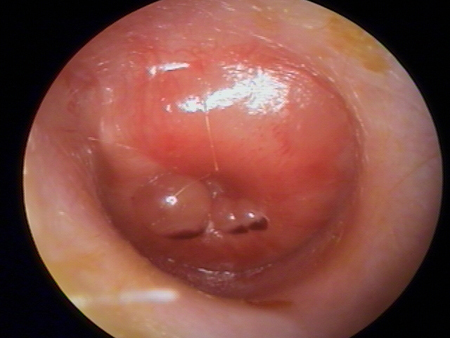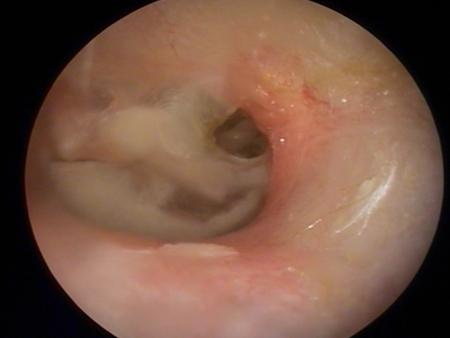Complications
Your Organizational Guidance
ebpracticenet urges you to prioritize the following organizational guidance:
Cliquez ici pour les guides de pratique clinique sur l'otite moyenne aiguë et leur mise en œuvre dans le contexte belgePublished by: ebpracticenet adminLast published: 2024Acute otitis media (NL versie)Published by: ebpracticenet adminLast published: 2024Occasionally, bullae may develop on the tympanic membrane of a patient with an episode of AOM. The bullous lesions will be apparent with otoscopy. [Figure caption and citation for the preceding image starts]: Otoscopic appearance of bullous myringitisFrom the personal collection of Dr Armengol [Citation ends].
The bullae usually resolve with antibiotic treatment of the underlying infection.
Perforation of the tympanic membrane may occur. Purulent otorrhea on the affected side will be evident at the time of otoscopy. [Figure caption and citation for the preceding image starts]: Purulent otorrhea, indicating that the tympanic membrane has rupturedFrom the personal collection of Dr Armengol [Citation ends].
Spontaneous otorrhea secondary to purulent AOM should be treated with antibiotics. The perforation usually heals rapidly.
Mastoiditis occurs very rarely.[57] This complication may arise when a bacterial otitis media extends into the mastoid air cells that are contiguous with the middle ear. Mastoiditis responds well to parenteral antibiotics; some patients may need a referral to an otolaryngologist for management.
Up to 50% of patients will have persistent middle ear fluid known as otitis media with effusion. [Figure caption and citation for the preceding image starts]: Otoscopy of otitis media with effusion, showing air fluid levels or bubbles, with normal tympanic membrane landmarksFrom the personal collection of Dr Armengol [Citation ends].
This may cause some transient hearing deficits, but is generally asymptomatic and requires neither routine follow-up nor treatment.[58]
Whereas an acute perforation of the tympanic membrane is likely to be the natural course of a substantial number of AOM episodes, a chronic perforation, one that does not close within 3 months, is not likely to heal spontaneously.[57][Figure caption and citation for the preceding image starts]: Otoscopic appearance of chronically perforated tympanic membraneFrom the personal collection of Dr Armengol [Citation ends].
Use of this content is subject to our disclaimer